This year we are using Brave Writer for our language arts as part of our 1st and 2nd grade curriculum picks. If you’re new to using the Brave Writer Darts, you probably have a ton of questions like what they are and how to use them. And I’m sure you are wondering if Brave Writer alone is enough or if you need to supplement for grammar.
This is a new way of doing language arts (for us), and after a rough 1st month of figuring out how to use the Darts, I’m LOVING it! My 8 and 6.5 year old are learning so much in the most organic way language arts could possibly be taught.
I’m hoping this post will give you an idea of what Brave Writer is, how to use the Darts, and how we divide the activities and read alouds each week.
I also want to mention I paid for this with my own money, and do not get any commission from Brave Writer of any kind if you buy this.
More homeschool posts for you to enjoy
- 2020-2021 curriculum picks for kindergarten and 1st grade
- Kindergarten homeschool schedule and curriculum picks 2019-2020.
- Busy Toddler’s Playing Preschool Curriculum Review
- Pros and cons of homeschooling
- The absolute BEST color printer for printing curriculum with cheap ink
- Homeschool Resource Page
- Homeschooling multiple grade levels
What is Brave Writer?
Brave Writer is a very unique literature based writing and language arts program that goes from kindergarten all the way up to high school.
Brave Writer helps kids learn to find their own original thought, and also teaches them the mechanics of writing through great books. Eventually…you combine both.
When people say they are “doing Brave Writer”, they could be speaking of the age based writing projects OR the literature based language arts program Or both (that’s us!).
Naturally, there’s some crossover between them. But for simplicity sake, I’m going to talk about “literature/grammar” (Darts/Arrows/Boomerang) separate from the “writing projects” (Jot It Down/Partnership).
If you are interested in seeing how we use Jot It Down for creative writing, go here.
Who is Julie Bogart?
Julie is the author of Brave Learner), professional editor, podcaster for homeschool parents, and veteran homeschool mom of 5 grown children. She’s spoken at many homeschool conferences, and is the creator of all Brave Writer curriculum.
She is your personal writing coach, teaching you how to teach your kids.
And she’ll help you to relax, ha! Since we are all apparently pretty bad at trusting the process. (Meee!)
Be ready to learn grammar and writing mechanics differently than public school
Brave Writer Darts are pretty opposite of how public school teaches grammar and writing. I’m ok with that because I didn’t retain what I learned long term apparently…and I was an A student!
Brave Writer has done what traditional language arts hasn’t…they make everything relevant and interactive.
An example on how you might cover compound nouns:
You might teach about compound nouns by first circling them in that week’s passage (picked from your Dart or Arrow).
Then you talk about what they are via the Dart, and run around the house looking for objects that are compound nouns (giving the kids hints is welcome too). You write them down in a list. Older kids can do that part or you can write for younger kids.
If your kids seem ready for more, Julie further explains closed and open compound nouns (if it’s one word or two)…something I can’t remember EVER learning, and definitely not this hands on.
That’s how I feel about each nugget of grammar we learn here! Ready to learn more about Brave Writer?
Brave Writer’s 3 step process
Julie breaks down writing into 3 categories and her products each match one of these stages:
- Original thought
- Mechanics of writing
- Writing projects
She believes that most writing curriculum focuses too heavily on initially teaching the writing rules to kids, but not how to find the words within. She doesn’t START by teaching how to diagram a sentence, or how to structure a paragraph.
Julie thinks good writers have something to say even before they learn how to fit it all together. They find a reason to write. Then, they can learn to arrange it well.
I love this philosophy! It really hit home when my 2nd grader wasn’t responding well being asked to write anything.
How are Darts and Arrows different than other language arts programs?
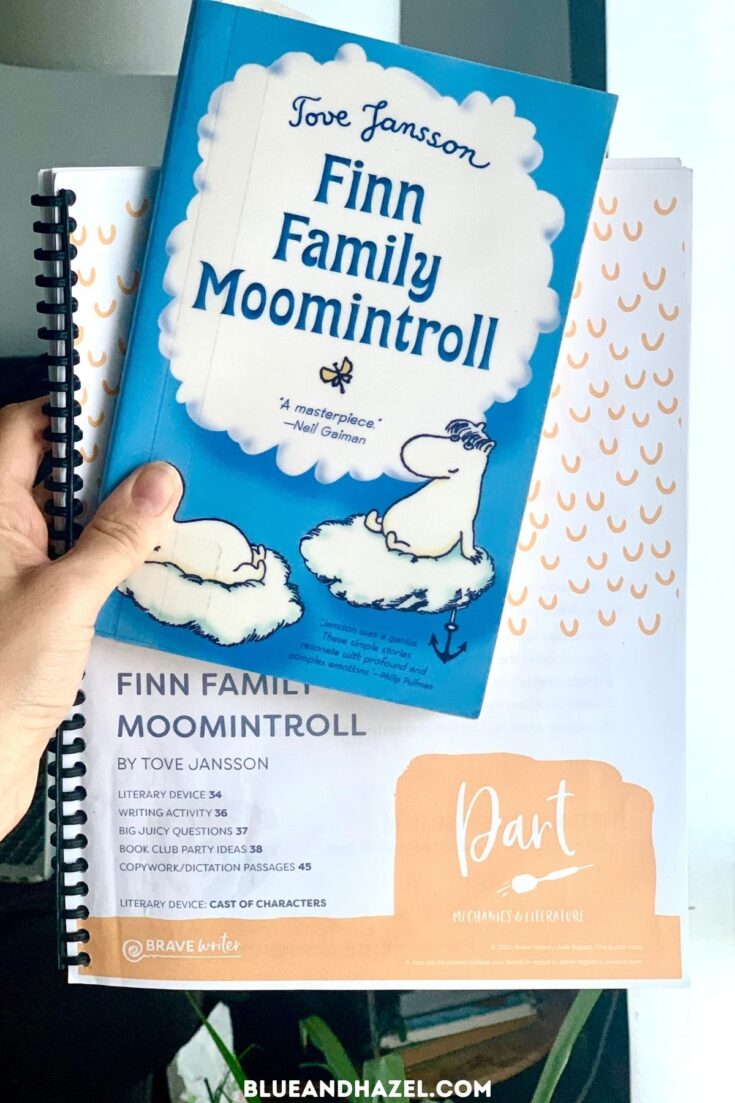
Brave Writer Darts and Arrows leave behind the worksheets.
Instead, you and your kids interact with the text together. You’ll point out grammar and literary elements and talk about why it’s there. (All of the how-to’s for this are in the Dart or Arrow guides that you’ll print with each book.)
Kids get to copy the passage and also practice “fixing” the same passage written incorrectly.
You’ll play games. It hardly feels like “school.”
How we use Brave Writer Darts explained on YouTube:
Which do I choose…Darts or Arrows?
Brave Writer curriculum is not arranged by grade, but by level based on age and ability.
The levels are called:
- Dart (around 1st-3rd grade or ages 8-10)
- Arrow (around 3-6th grade or ages 11-12)
- Boomerang (middle school or ages 13-14)
- Slingshot (high school or ages 15-18).
While younger siblings can learn a lot by tuning in (especially to the read alouds), Julie recommends waiting to start the Dart until your child can read.
If you have kids in both the Dart and Arrow category, I’ve heard many mamas say not to worry about if it’s a Dart or Arrow…pick the books you prefer.
Then, you can beef up or tone down the amount of copywork and writing based on age…which are supposedly the main differences although I’ve yet to use an arrow so I can’t say 1st hand.
What exactly is a Brave Writer “Dart” or “Arrow”?
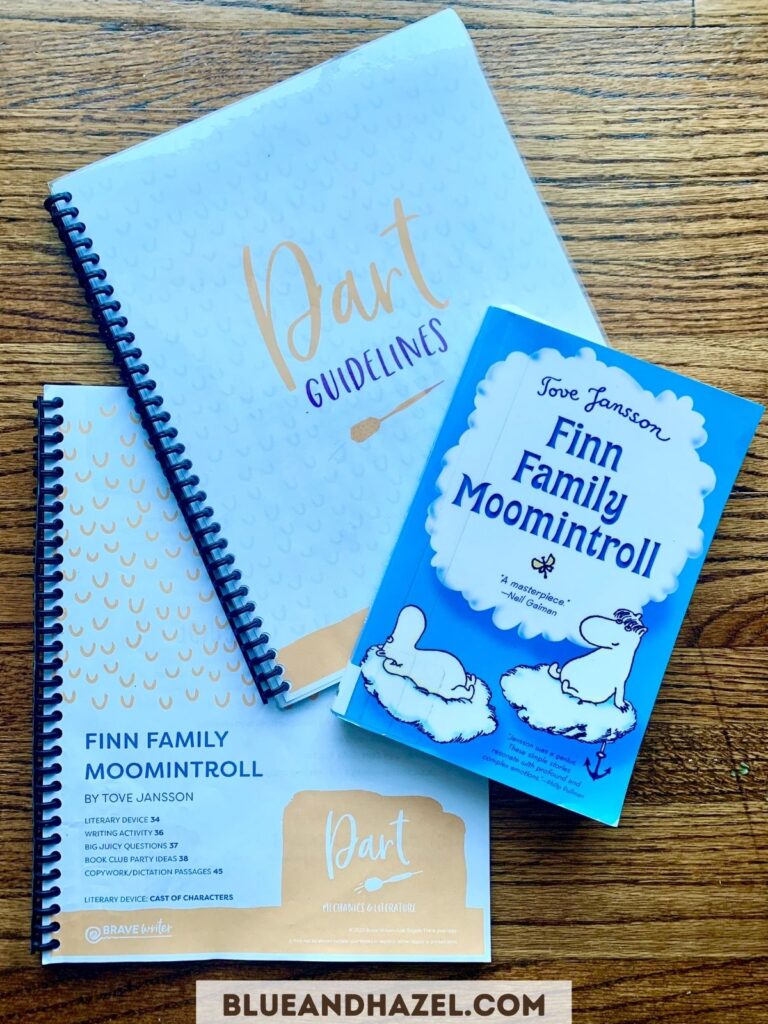
Darts and arrows are simply month long literature guides that help you teach language arts. They come as a PDF file that you’ll print and have bound. Or, bind your own! Here’s how we bind homeschool curriculum.
Here are some of the highlights you should know:
Each Dart is based on a book you’ll read together. For example, our first Dart was “House At Pooh Corner”. All of the copywork was from that book, as well as grammar, literary device, and writing activity for the month.
Each Dart is made to last 4 weeks. Julie recommends not going any faster, even if you finish the book early or all the material in a Dart. All of the material is broken down by week for you, but you’ll have to create a plan that works for you for each day. I’ll share ours in a minute!
Darts allow me to teach my 1st and 2nd grader together. Such a time saver! My older child grasps more spelling and grammar than the younger…while my younger is exposed to it and will learn it again as a 2nd grader. Both do copywork, but I expect a little more of my oldest.
It teaches the parent how to teach. Everything I need to teach the Dart comes in the Dart Guide specific to each book (essentially a teacher’s guide). I needed some hand holding so this was a big selling point.
There are no worksheets. Ok, I guess there are a few. Like reverse dictation where you edit the passage written incorrectly. But not much more! That’s crazy, right? How do you teach language arts without worksheets?
The Darts have passages from the book that point out grammar, spelling, and literary devices.
We write the weekly passage down on a whiteboard and highlight/circle/underline what is presented in the guide.
Then the kids complete copywork and dictation in a spiral notebook.
Be sure to check out the Brave Writer Fan Facebook page to see more ways that families use the Darts and Arrows.
The 4 basic sections in each week’s Dart
There are 4 basic chunks in each Dart…all of which have to do with the passage Julie picks out.
- Copywork & dictation
- What To Note section
- How To Teach This Passage Section
- Spotlight Grammar (1st 3 weeks) OR Literary Device (4th week)
Copywork & Dictation Section of the Dart
Julie recommends copywork towards the beginning of the week…and 1 dictation method towards the end. She tells you how to do it in the Dart guide. So don’t worry if this sounds like, whaaa?
What To Note Section of the Dart
Mark up this page! These are things you’ll point out to your kids IN the passage that you’ve written on the board or printed out for them.
I like to point these out on day 1. Some of the things here get explained in MORE detail in the other sections for the week.
How To Teach This Passage Section
This is for YOU. Highlight it. Mark up if there’s any parts you if can read to the kids as is. Cross out what to skip.
Spotlight Grammar/Or/Literary Device
This section is my favorite!! We spend our whole language arts time doing just this on the last day of our week (so Thursday usually.)
What’s in the spotlight grammar and literary device sections?
So I didn’t notice this right away when we started, but weeks 1-3 have a page called “Spotlight Grammar” with a SHORT helpful activity. I usually do JUST this section on our last day for the week.
For Finn Family Moomintroll spotlight grammar week 1-3 covers:
- Pronouns. Matching activity is to have kids tell you something someone did WITHOUT using pronouns! So instead of ” She went to the park to play with her friends”….they’ll have to say, “Alex went to the park to play with Alex’s friends.” It’s fun and points out the purpose pronouns serve!
- Attribution Tags. Matching activity is to say “yes” with all the different attribution tags listed. “Yes,” he whined. “Yes?” she asked. “Yes!” she shouted. etc.
- Compound Nouns: Matching activity is to make a list (you can write for them) all the compound nouns you can find in your house. This was fun and memorable! Driveway. Pillowcase. Whiteboard. Toothbrush. Living room. Ice cream. We made a big list.
I needed help so I googled pronouns and gave them hints where to look for them till they guessed it. I still struggle as an adult knowing which words are written as one word or two…so a few of these are probably incorrectly written by me.
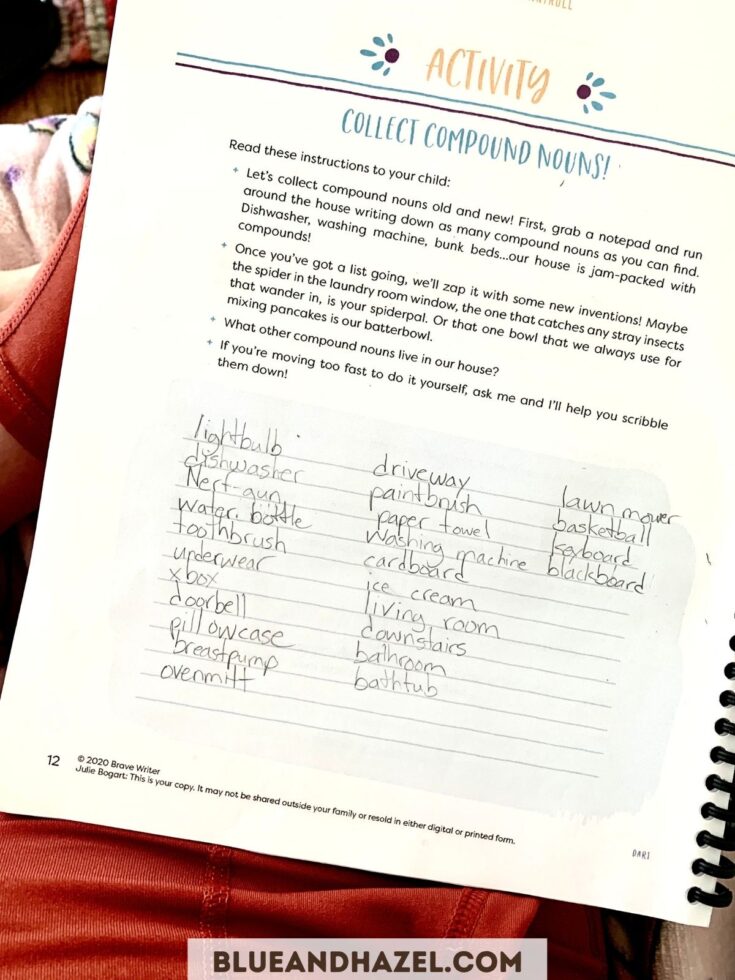
Week 4 doesn’t have a spotlight grammar, but says to review those and explore the Literary Device. In this Dart it’s talking about the Cast of Characters and their personalities. The matching writing activity is to pick another book and make a list the main characters names and personalities.
You will see that SAME pattern in each Dart, which makes it much easier to follow after you’ve done a full month or two.
For House At Pooh Corner the Spotlight Grammar for the 1st 3 weeks:
- Phrases around telling time. Matching activity was listing all the time phrases we could think of.
- Punctuation. Matching activity was switching out periods for exclamation points and question marks and saying them so we could hear the difference they make.
- Conjunctions “and”, “or”, “but”. Matching activity was photocopying any page of a book and highlighting all of the and/or/but conjunctions.
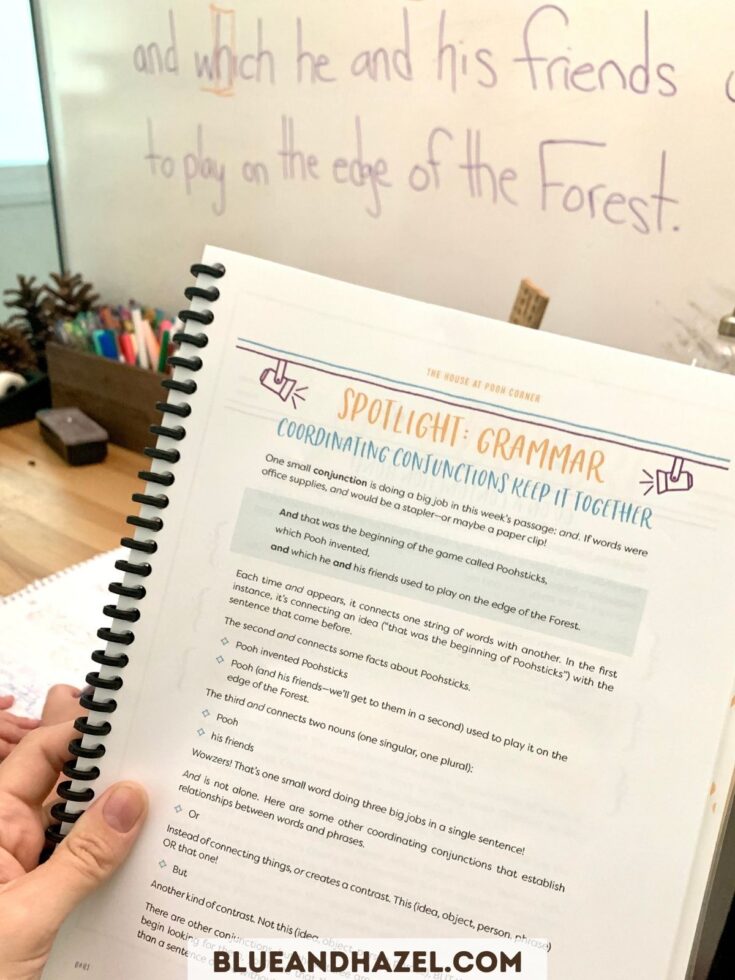
Week 4 doesn’t have the spotlight grammar but says to review and cover the literary device. We explored synonyms. The matching activity was a synonym race where we listed about 5 words and had to see which one had the most synonyms we could come up with! Easy. Fun. Memorable.
Is Brave Writer a complete language arts program?
Yes, it is if you use both the writing program + language arts program. But some parents do choose to add other things in.
For my kids’ ages we chose to buy the Darts for a complete literature based language arts, and Jot It Down for creative writing.
I actually liked the language arts we left a lot from Masterbooks. I still recommend it if you want a traditional gentle workbook style L.A. It’s open and go (Brave Writer isn’t so much) and has worksheets (here’s my review on Language Lessons For A Living Education).
Masterbooks lessons are short and teach the basics. I originally planned to sneak it in alongside Brave Writer “just in case” Brave Writer wasn’t enough. But so farI haven’t opened it.
I feel we are doing plenty in 1st and 2nd grade with Brave Writer and they aren’t bogged down with so so much information by doing 2 language arts programs.
I do plan to eventually use Fix It Grammar as the kids get to 3rd or 4th grade even if we continue with Brave Writer. I’ve just heard awesome things and that Fix It Grammar is short, like 5-10 minutes a day or something.
What you won’t find in Brave Writer Darts
If you are looking for a rigorous curriculum to get your 2nd grader diagramming sentences or your 4th grader writing formal essays that include all the things…this is not for you. Julie will teach those things, but in a more natural way over time.
Here’s what you won’t get with a Dart or Arrow:
Darts are not scripted
There are actually quite a few chunks and sections I just read straight from the Dart! BUT not all.
You can’t just read the whole Dart guide to your kids. I tried that our first week and I lost them because it was too wordy, whoops!
It’s written to you, and so you’ll want to read the whole week of whatever Dart you’re on and highlight what you want to point out or say. If I’m going to read a chunk of Jullie’s words to describe something, I’ll literally write in my Dart, “say this.”
This isn’t a full on spelling course
There are about 5 spelling words per week that are suggested to practice and will be used for one of the dictation techniques.
But they don’t pertain to a certain spelling rule or pattern. So if you find your kids need more spelling help as you begin…you can use another spelling program.
It’s not a priority for me at this age so for us it’s enough. We may use something else if needed later on in elementary. But maybe not!
This is also not a “how to learn handwriting” curriculum
Brave Writer requires copywork which sharpens their handwriting, spelling, punctuation, grammar, and attention to sentence structure. But there’s no instruction on how to form your letters correctly in a Dart.
We are using Handwriting Without Tears 1-2 pages a day for that. Days the kids do copywork with Brave Writer…I don’t do any other handwriting because it’s a lot for them to do both.
You won’t find a detailed daily to do list
Through trial and error and a few awkward days, I had to figure out what parts of the guide we like to do each day and made a routine. I’ll show you what we do day by day in a minute so you have an example to follow.
There’s no right or wrong way to arrange what’s in that week. It can all be talked about in any order really. Like I said, that took us about a month to get used to the flow.
Is Brave Writer open and go?
No. In fact, I treated our first Dart (the language arts program) like it was our first month and totally lost my kids attention. They didn’t respond well to long periods of silence as I skimmed over what I was supposed to do that week.
My best advice is to read one week of your guide before you get up in front of your kids. Underline what you want to say in the “Note this” and “How to teach this passage” sections. Some of it I just read to the kids as is.
I make boxes around pieces of grammar I’ll be pointing out too, and put an x on anything I’m skipping.
Julie says in the Dart guidelines to pick a few things to go over each week but that you don’t have to do it all if it seems way over their head or too much. It’s all there so you can easily adjust to where your oldest child is at.
This is hard if you’re type A because you want to finish everything and check the box. But follow your child’s attention span here. If they learned ONE new thing that sticks, that’s so much better than drilling 3 things that go over their heads.
See how I mark up my Dart below for teaching. You can see what I decided to skip, too.
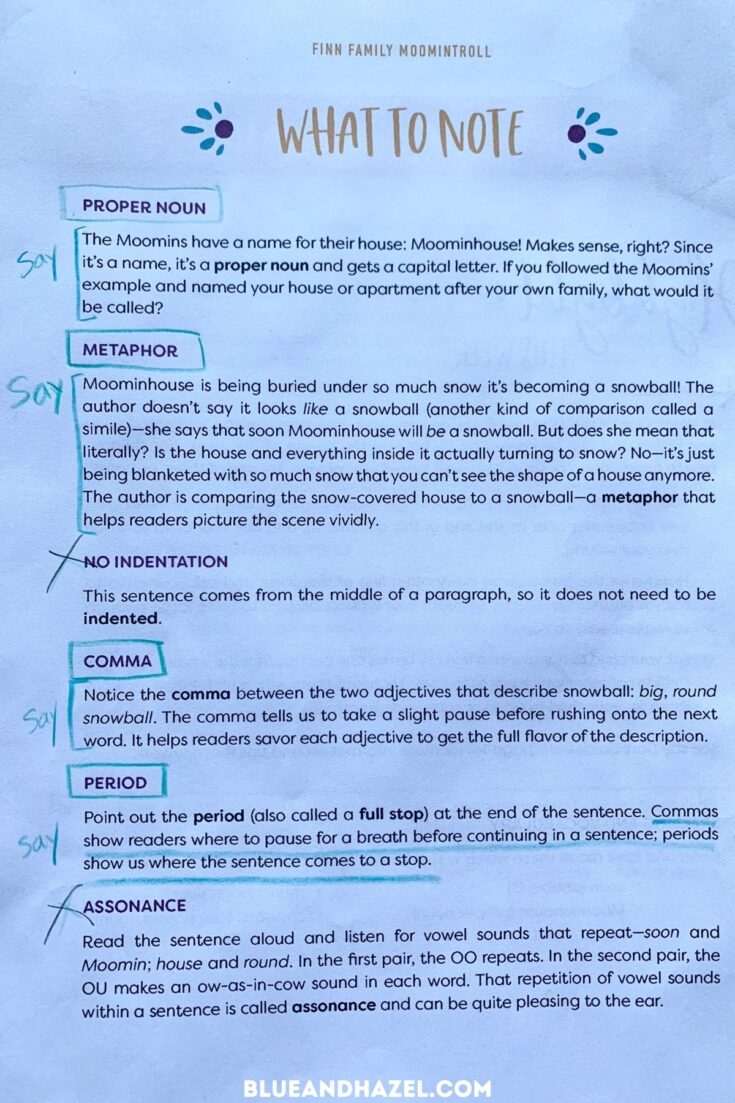
Do you have to use all the Darts in order not to miss any grammar?
My biggest confusion before I bought our Darts was how to ensure we’ll get a year’s worth of grammar if I pick and choose the Darts. Especially since there are too many Darts and Arrows to do them all and ALL of them have different random pieces of grammar inside.
FYI, there are now around 30 Dart book guides to choose from and around 100 Arrows.
For a full, detailed answer to that question, read my post on Grammar Lists For the Darts and Arrows. I explain exactly how I feel about this 2 years later and where you can see a list of the exact grammar concepts in each Dart or Arrow I’ve purchased.
Julie says you don’t have to do them all, or even go in order! But how? Won’t our kids miss something?
Yes and no.
Each Dart really is a stand alone. You WILL cover something new. I figure that as long as we are doing enough Darts in a year, say 8-10, it’s fine. Because we are soaking up so much new material, even if it’s “out of order” which is just arbitrary anyways.
Update spring 2023: After 2 years using the Darts…we managed to do 5 with my 1st and 2nd grader and 7 with my 2nd and 3rd grader. That seems about my max I can do, and it has been SO great. We supplement spelling with my 3rd grader, but that’s it.
There’s a lot of overlap in each, meaning tons of review. You won’t just learn about commas once, capitals in another Dart, etc. The stuff kids really should know at this age comes up over and over again.
Things I learn to point out from one Dart tend to be easy to point out in others…even when it’s not listed to do so. Things like circling capital letters, punctuation, contractions, quotations, etc. We highlight these every week in the passage.
How to practice what you learn in the Dart in a natural way while reading
One easy thing to do to help your kids APPLY what they’ve learned (without worksheets) is to point out grammar terms as your read them. For instance, we learned about similes one day. So if I’m reading the next day and spot one…I say, “Look, a simile!”
Same with alliterations. We learned about those, and since it was brand new I figured it might not stick right away. Heck, I didn’t even remember what an alliteration was till Julie taught me.
So we pointed out some in the book as we found them. “sweetly singing” or “misty moonlight” or “picture perfect”…I’d just stop and ask them point it out or ask them what it’s called.
What you will miss by skipping over Darts
However each Dart does contain ONE focused literary element and short writing activity focusing on that which might be missed. You can see which literary element is included in each Dart, Arrow, Boomerang, etc in this spreadsheet, along with the time frame and setting.
For example, if we skipped House At Pooh Corner dart, we would have missed focusing on synonyms. And I don’t know when that would be brought up again?
But my philosophy is that if we don’t need to know IT ALL right now. We just need a slow trickle of new information to be going forward.
I would say if you only do 3 Darts a year…ya…you would create gaps and need something else. But you don’t have to finish all 10. I’m planning on doing about 7-8.
Example literary element and writing activity
Like I just mentioned, The House At Pooh Corner’s literary element was synonyms and our matching activity was to create a synonym race!
First I read Julie’s paragraph stuffed with the same words over and over again. And next I read an improved version of the same passage using synonyms.
The kids had to pick which one sounded better and tell me why! That’s how they not only learned the definition, but saw the reason for using synonyms in good writing.
How to use the Brave Writer Dart (here’s the main parts each week)
If you’re used to open and go curriculum, this might initially feel super frustrating. It was to me, and I had to create some kind of mental “do this on Monday, do this on Tuesday…” type thing.
Each week you’ll aim to arrange these things into your language arts time:
- Read some of the book. It’s totally fine to finish early or take longer than a month. I don’t time it. We just pick it up each day and read as much as we can till interruptions happen.
- Use the weekly passage for copywork and one type of dictation (the Dart guide tells you how to do these and it gets easier once you’ve done it once)
- Discuss the “spotlight grammar” from weekly passage
- Ask 1-2 of the “Big Juicy Questions” about the book. There are clues in the guides when to stop and ask some of these (all listed in the back of the Dart.) I know there’s a couple to ask before we start the book, when we finish, and a few as we read. It’s fine to miss them too. It’s literally just getting you into the habit of talking about a book if you are new to that.
- Literary device/very short writing activity to match the literary device. Each month long Dart comes with 1 of these. It’s listed on the last week of the Dart but you can do it any of the weeks on any day! It takes just 1 day. Our last one was talking about synonyms and the activity was a synonym race to see which words listed we could find the most synonyms for. Easy peasy and fun.
- Optional ad ins would be Poetry Tea Time and Free Write Fridays to create a language arts lifestyle also referred to as the “Brave Writer Lifestyle”.
What order you teach is totally up to you. This is where many (including myself) struggle because it’s almost too much freedom.
Some do it once a week for longer, while others break it up into several days but shorter chunks. Give yourself a full month to figure it out, and tweak your schedule.
Our Sample Dart Schedule
Monday
Copywork & Grammar.
I write the passage on the white board and we highlight it up. Anything on the “things to note page at the beginning of each week gets pointed out.
I’ll alternate who gets to underline or circle something and we talk about why it’s capitalized or why that comma is there between 2 adjectives.
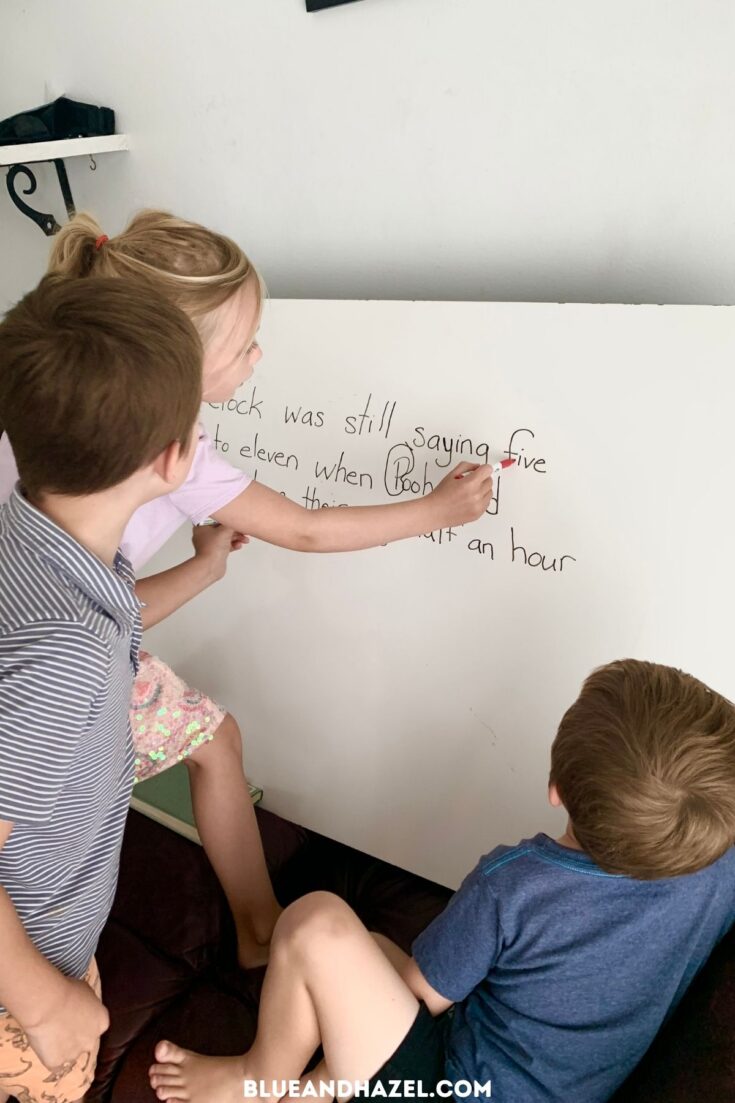
(Don’t worry…the Dart explains all the “whys” so you don’t have to know this.)
Usually its things like:
- Capitals
- Periods or question marks
- Commas
- Quotation marks
- Anything else the Dart tells me to point out
Copywork time is 10 minutes or so. Everyone copies into their wide ruled notebook with the date next to it. This lets me keep it all in one spot and I can see progress throughout the year.

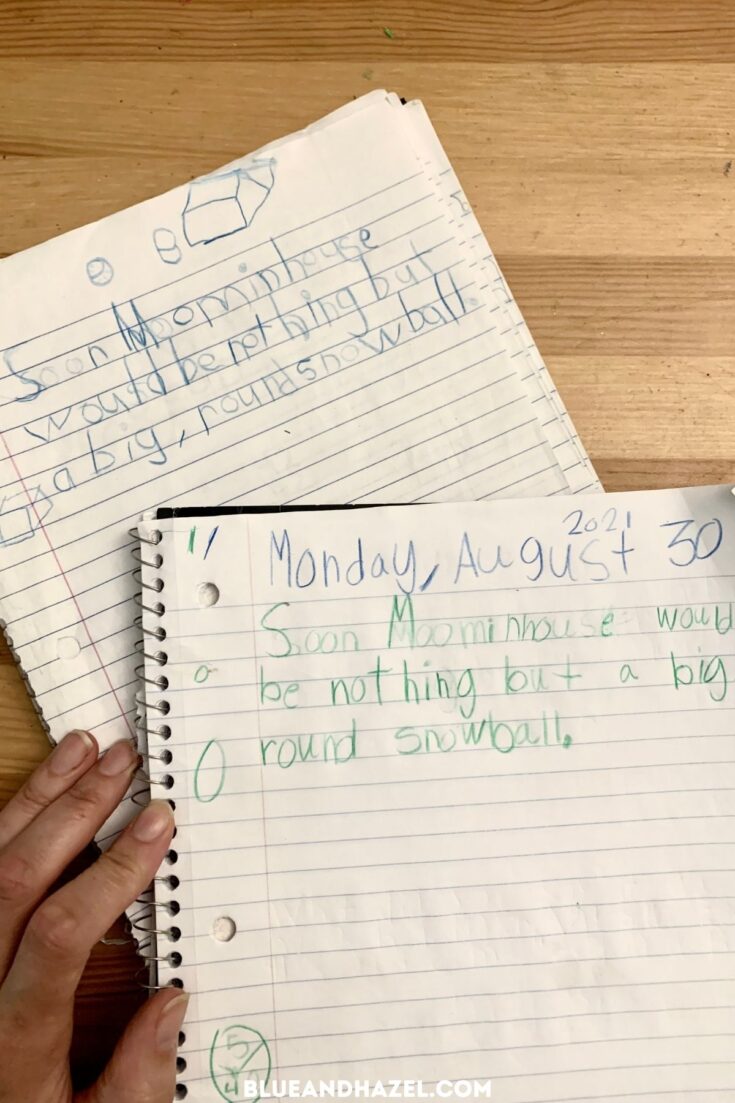
By this time they are wiggly and done!
Tuesday
Grammar. I make notes in my Dart what to point out to the kids because it’s not scripted and I don’t teach it all. 1-2 new concepts at a time works best for us, so it takes us 2-3 days to cover the grammar in the Dart.
Practice the spelling words that will be used for french dictation later in the week. There’s usually 4 or 5. I write them on the board, and have the 8 year old copy them into his notebook 3 times or so for each word. My 8 year old does this, but I don’t have my 6.5 year old doing this right now until she’s a stronger reader.
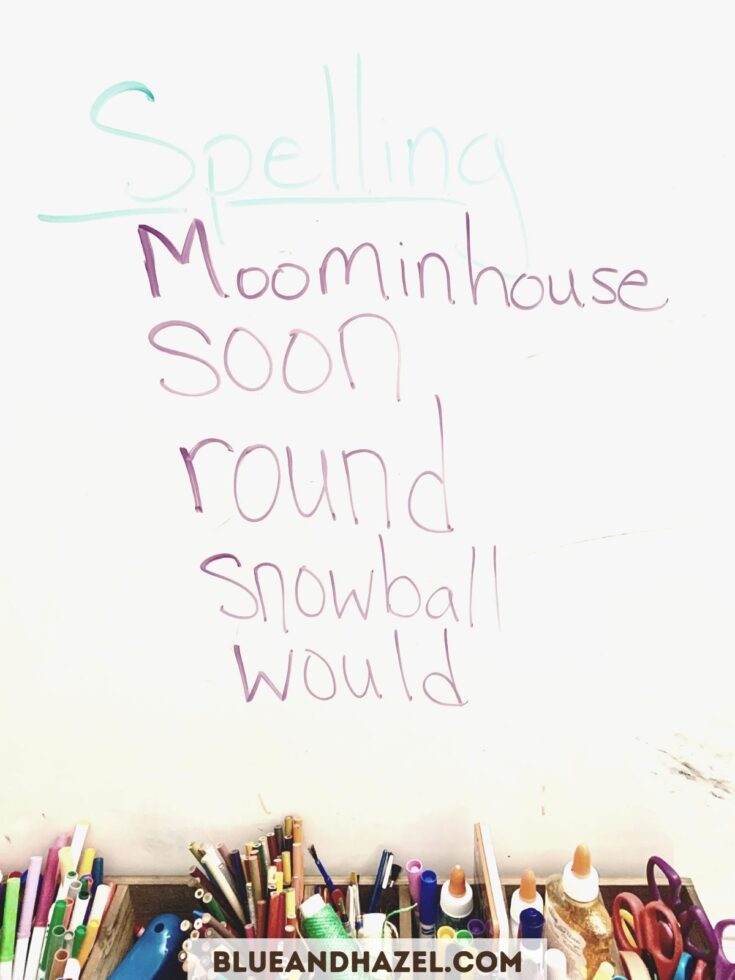
Sometimes I’ll ask my 8 year old to point out a sound blend, or silent letters, etc.
Wednesday
Jot It Down project. I don’t do the Dart and instead make time for their creative writing. There’s 10 month long writing projects where I write their words for them. Here’s how Jot It Down worked in our homeschool.
For the fairy tale project, I read several versions of a story if we can find them, and then they draw a picture and I write their retelling of it. We’ll do this for several stories before the fairy tale project is done, but one a day is all we have attention span for.
Thursday
Finish anything in the Dart I haven’t had time for yet.
Dictation. The Dart tells you which one because it changes each week. The Dart Guidelines tell you how to do them both. But here’s a peek at what we do.
Two types of dictation we are doing in the Dart
French dictation has about 4-5 missing words on the printed out passage I hand him. Then I slowly read the passage and when he sees that a word I read is missing from his sheet, I pause and he writes it down. The words are our weekly Dart “spelling words” practiced earlier in the week. So the words are at least familiar.
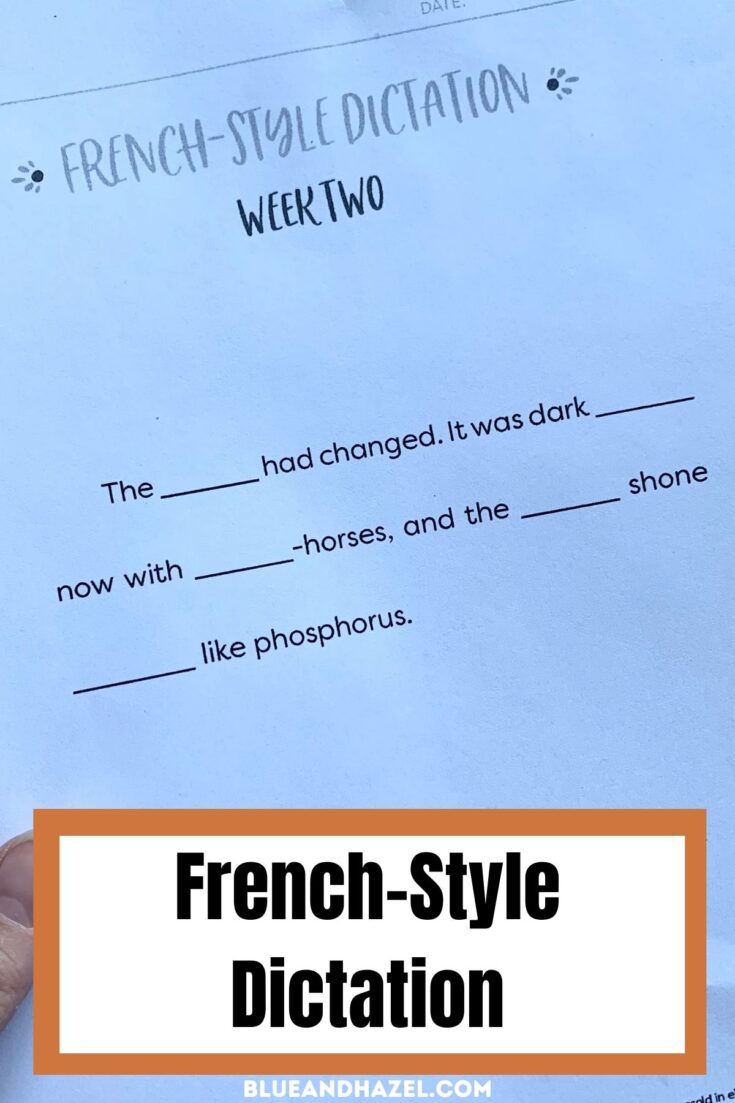
Reverse dictation is just “editing”. You can print out the wrong and correct version of the passage and hand them to your child to fix as many mistakes as they can find. Or, you can write the wrong version on the board and have them come erase and fix it there. (I remember doing this in elementary school!)
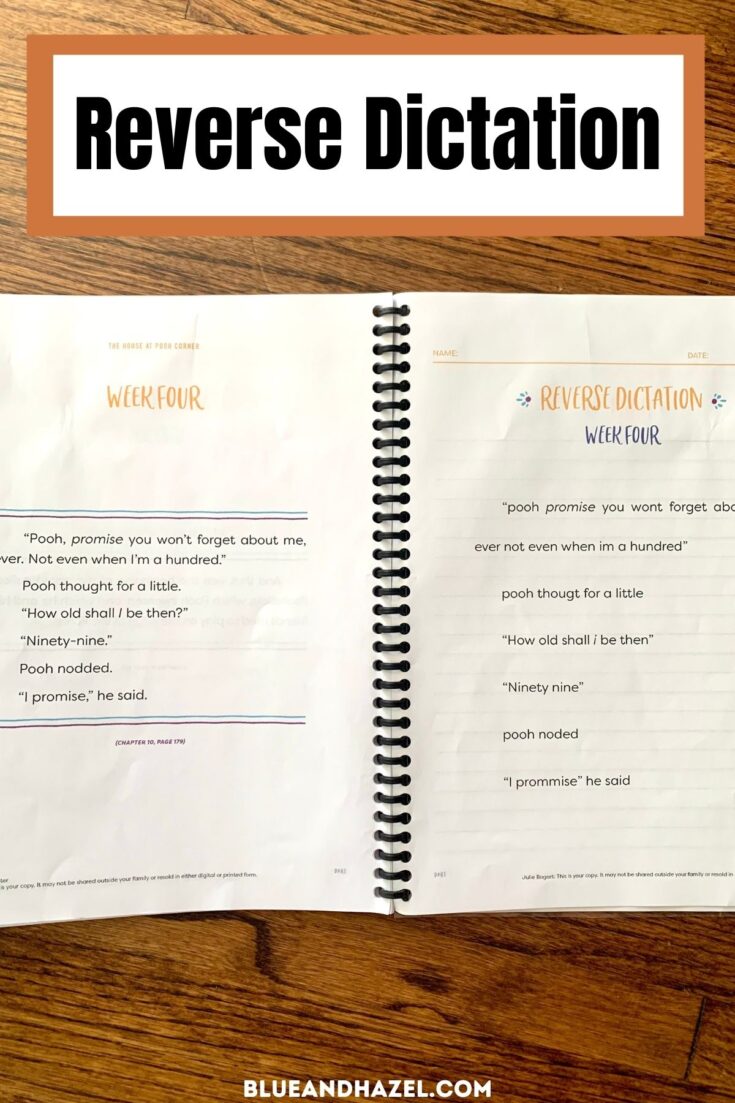
Friday
No Dart Fridays! We do a nature co-op to fill the morning. I see us doing “Friday free writes” (as Julie calls it) someday but not for now.
How are Darts and Arrows different?
I’ve not used an Arrow yet, but from the many reviews I’ve read the MAIN difference seem to be that the copywork passages and 1 writing activity get longer with Arrows. And also the books can be a little bit longer or written for slightly older kids.
So if you are using an Arrow with younger kids in the mix…shorten their copywork and help them with the physical writing of the monthly writing activity in the back.
I’ve been told if you catch more than 3 mistakes in their copywork…to shorten it as well.
It’s not a big deal to me that some books are longer than others.
Next year when I have a 2nd and 3rd grader I’ll try out a mix of Arrows and Darts based on what books we want to read!
Update spring 2023: Watch this YouTube video on how we’ve used Brave Writer Darts with my 2nd and 3rd grader!
My main recommendation would be to look at each book first and read reviews. Then you can decided if it’s fine for your family.
I did that by going to Amazon. It was easy to get a little snippet of what the book would be about and why parents did or didn’t like it.
Language Arts games
I love finding games for them as a more hands on way to learn spelling and grammar. There are plenty! Check out my list of spelling and language arts games.
I also have a word roll game thats SUPER simple. Print it out and use 1 die to practice any of your spelling words!

Where we were at before trying Brave Writer
I began looking for ways to teach writing when I noticed my son just avoided writing at all costs. Part of it is his lack of love for physically writing/doodling/coloring/etc. But it made me sad one day when he said, “I can’t write a story because I don’t know what to say.”
He’d be asked to write 2 sentences on a worksheet and freeze. His sentences were SHORT as possible so he could be done. Things like, “I played. And watched a show.” I didn’t know how much writing I should expect from a 1st or 2nd grader…and was worried I was failing him somehow.
I didn’t know if “I played” was enough to let him be done, or if I should make him write “I played Legos.” Or should he write, “First I played Legos. Next I watched a show.”
You get the idea…I needed someone to teach ME what to expect from him and how to move him forward from where he was at. Julie has LOTS to say about this!
Brave Writer has helped me get out of the “grade level” way of thinking
At first I just thought we just needed to back up and practice handwriting so he could write faster. Or maybe practice spelling so his perfectionist self wouldn’t get frustrated and ask me how to spell ALL the things ALL the time.
I asked a few friends with kids in public school what their kids were doing. One sentence in kindergarten, a short paragraph in 1st grade, and a page story by end of 2nd. Spelling words were still mostly CVC words and things like sight words and number/color words were often posters on a wall for kids to reference.
I KNOW it’s fine to be ahead or behind that…homeschool’s all about personalized education after all. But every new homeschool parent feels this pull to compare abilities with peers.
But Julie just calmed me the heck down! She’s had 5 VERY different kids that have had reading and writing skills develop at very different ages. They’ve all picked up what they needed to…the way she teaches…by the time they graduate.
You become a student with your child
Teaching language arts intimidates me because I’m not a great writer…and don’t enjoy English grammar at all. I wasn’t exposed to almost any of theses great books till now.
Harry Potter is the only series I can remember devouring when it came out. And we had to wait each year for the next book to be written! Till then I didn’t want to read.
My mom taught high school English…but she was never MY teacher in charge of what I learned.
In fact, I’ve never enjoyed writing UNTIL I started blogging and had something to say.
As far as knowing all the technical terminology of writing (like defining an adverb)…lets just say I dumped a lot of that and need to be retaught WITH my son.
Just know that Julie teaches YOU too in the Dart Guides.
How much does Brave Writer cost?
To order a year’s worth of Brave Writer Darts or Arrows (10 of them), it’s $129.
But I’d recommend NOT buying the year ahead and instead buying individual Darts based on the books you want to read. $15 each.
Make yourself try at least 2, because you’ll spend the 1st one figuring out the flow (maybe still unsure if you even like Brave Writer) and the second will go much smoother!
I also bought Jot It Down for $50. It’s the creative writing program where you do projects with your kids but “Jot down” most if not all of what they say until they are physically writing more.
Does Brave Writer ever go on sale?
While I don’t think there are often sales, I did hear that last Black Friday Julie offered the Darts buy 1 get 1 free. So I’m planning to buy a bunch then if they do that again to get us through the whole year.
Lets connect!
I’m @blue.and.hazel on Instagram if you want to keep up with more of our daily homeschool life. Or, join my new YouTube channel where I’ll be posting reviews and homeschool life.
Elizabeth
Thursday 29th of June 2023
Where can we learned more about Julie’s approach to teach kids LA, YouTube or a book? I think it’s very interesting and would like to buy a dart for my 7yo. Thank you so much for all the details, it’s very helpful
Liz
Wednesday 5th of July 2023
I would start with Julie's free materials. She has a podcast "Brave Writer", and is active on Instagram with lots of great advice and tips there. She has a YouTube channel I'd watch free videos from on specific topics. If you're still intrigued she has a new ish book out called The Brave Learner which is a great overview of The Brave Writer Lifestyle and how it all flows together into life and homeschooling.
Kara
Tuesday 2nd of August 2022
Were your kids reading fluently when you began using Dart? I am looking into it for my 8 year old, but she is only 1/4 through AAR level 3 and is more of a reluctant reader/doesn't read much on her own yet. I also have a 6yo who isn't reading yet.
Liz
Tuesday 2nd of August 2022
My 2nd grader (newly turned 8) was reading a ton, and my 7 year old wasn't reading much yet nor interested. They both really enjoyed the stories, were able to benefit from copywork and different styles of dictation, and both progressed in their understanding of basic grammar with JUST the Dart. Julie really frees you to meet each kid where they are at! I felt like the Dart concepts were perfect for my 8 year old, and a little over my 7 year olds head at times so I didn't expect her to grasp as much. Though she got really good at starting sentences with a capital letter, ending with punctuation, and spacing each word a finger width apart. Plus she felt included and listened in here and there on things like compound nouns, what a cast of characters is, etc. So that's a win! Hope that helps.
LeannR
Friday 24th of September 2021
Thank you so much for sharing this detailed account of how you use the Dart/Arrow! I've been wanting to jump in and try it for a month because I'm honestly getting bored with our LA program. My family loves to read aloud and I think this will be a great fit for us. I love the idea of learning grammar from "real" books where they can see the true application of it. This post was really helpful in showing me how the Dart could be used daily/weekly.
Liz
Saturday 25th of September 2021
I'm so glad! Yes, if you're ready for a change do it! This is so different than others and involves a lot of conversation and literature rather than worksheets. But I truly love it! Let me know if you have any questions along the way. I'll be posting a video of how we use the Dart soon.